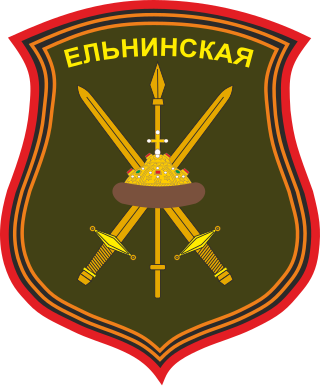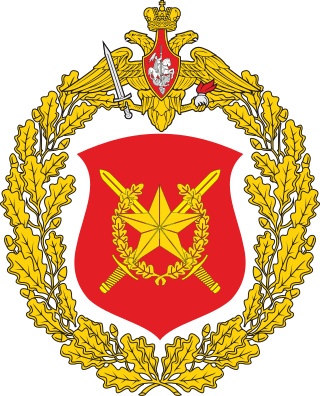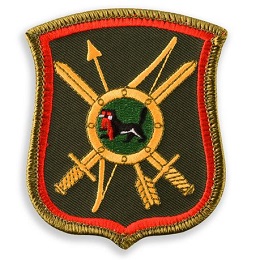
The 2nd Guards Tatsinskaya Tank Corps was a tank corps of the Soviet Union's Red Army that saw service during World War II on the Eastern Front of Europe. The unit's most notable moment was in the raid on Tatsinskaya during Operation Little Saturn in World War II. After the war, it continued to serve with the Soviet occupation forces in Central Europe. It was originally the 24th Tank Corps. The formation had approximately the same size and combat power as a Wehrmacht Panzer Division, and less than a British Armoured Division had during World War II.

The 144th Guards Yelnya Red Banner Order of Suvorov Motor Rifle Division is a motorized infantry division of the Russian Ground Forces, reestablished in 2016 with its headquarters at Yelnya, Smolensk Oblast.

The Order of Lenin Moscow Military District is a military district of the Armed Forces of the Russian Federation. Originally it was a district of the Imperial Russian Army until the Russian Empire's collapse in 1917. It was then part of the Soviet Armed Forces. The district was awarded the Order of Lenin in 1968. In 2010, it was merged with the Leningrad Military District to form the new Western Military District. In December 2022, Defense Minister Sergey Shoigu proposed to reestablish it along with the Leningrad Military District, a decision confirmed in June 2023 by Deputy Chief of the General Staff Yevgeny Burdinsky. The district was formally reconstituted on 26 February 2024 by a Presidential Decree №141, after the Western Military District was split.

The Baltic Military District was a military district of the Soviet armed forces in the Baltic states, formed shortly before the German invasion during World War II. After the end of the war the Kaliningrad Oblast was added to the District's control in 1946, and the territory of Estonia was transferred back to the Baltic Military District from the Leningrad Military District in 1956.

The 2nd Guards M. I. Kalinin Taman Motor Rifle Division is a Guards mechanised infantry division of the Russian Ground Forces. Its Military Unit Number is 23626.

The 18th Guards Insterburg Red Banner Order of Suvorov Motor Rifle Division, is an active division of the Russian Ground Forces.

The 2nd Guards Tank Army was a large military formation of the Red Army and Soviet Army, later part of the Russian Ground Forces of the Russian Federation.

The 38th Separate Guards Vitebskaya order of Lenin Red Banner order of Suvorov Motor Rifle Brigade is a mechanized infantry brigade of the Russian Ground Forces, part of the Eastern Military District. Military Unit в/ч 21720.

The 90th Guards Rifle Vitebsk Division was an infantry division of the Red Army during World War II. Formed from the 325th Rifle Division in recognition of its actions during the winter of 1943, the division fought in the Battle of Kursk, the Belgorod-Khar'kov Offensive Operation, Operation Bagration, the Baltic Offensive, the Vistula–Oder Offensive, and the East Prussian Offensive.
The 1st Guards Proletarian Moscow-Minsk Order of Lenin, twice Red Banner Orders of Suvorov (II) and Kutuzov (II) Motor Rifle Division was a division of the Red Army and Russian Ground Forces active from 1926 to 2002.

The 1st Guards Stalingrad Composite Aviation Division is an Aviation Division of the Russian Aerospace Forces. It was originally formed as the 226th Assault Aviation Division in May 1942 and became the 1st Guards Stalingrad Assault Aviation Division for its performance in the Battle of Stalingrad. The division fought in the Melitopol Offensive, Crimean Offensive, East Prussian Offensive and the Battle of Königsberg. By the end of the war, the division had been awarded the Order of the Red Banner twice, the Order of Lenin and the Orders of Kutuzov and Suvorov 2nd class. Postwar, the division relocated to Belarus. In April 1956, it became a bomber division but was converted to a fighter-bomber unit in 1957. In 1989, it became a bomber unit again and moved to Krasnodar in 1993. At Krasnodar it became an assault unit. The division moved to Yeysk in 2002 and disbanded in 2009. It was reformed in 2013 with the addition of extra fighter units.

The 103rd Separate Guards Airborne Brigade is an airborne brigade of the Belarusian Special Forces. Its predecessor unit was the 103rd Guards Airborne Division, which was a division of the Soviet Airborne Troops. It was established in 1946 and disbanded in 1993, a year after its transfer to the Armed Forces of Belarus. The division was formed from the 103rd Guards Rifle Division, which fought as infantry during the final months of World War II in the Vienna Offensive following its formation in late 1944.

The 51st Guards Artillery Brigade is an artillery brigade of the Belarusian Ground Forces, based at Osipovichi.
The 23rd Rifle Division was an infantry division of the Red Army and Soviet Army, formed three times.
The 17th Guards Rifle Division was an infantry division of the Red Army during World War II. It was created on March 17, 1942, from the first formation of the 119th Rifle Division, in recognition of that division's stalwart defense against German Army Group Center in the Battle of Moscow, and in the subsequent strategic offensive that threw the German forces back from the capital. It became the 123rd Guards Motor Rifle Division in 1957 and converted into the 129th Guards Machine-Gun Artillery Division in 1989. In 2001, it was converted to the 17th Guards Motor Rifle Division and became the 70th Guards Motor Rifle Brigade in 2009. The brigade was reorganized as the 114th Guards Motor Rifle Regiment of the reformed 127th Motor Rifle Division in 2018. The regiment is currently based in Ussuriysk.
The 120th Rifle Division was an infantry division of the Red Army, formed three times. Its first formation became the 6th Guards Rifle Division for its actions in the Yelnya Offensive. Its second formation became the 69th Guards Rifle Division for its actions in the Battle of Stalingrad. The division was reformed a third time in late April 1943. It was disbanded "in place" with the Central Group of Forces in the summer of 1945.

The 29th Guards Vitebsk Order of Lenin Red Banner Rocket Division is an intercontinental ballistic missile division of the Russian Strategic Rocket Forces. The division was formerly part of the Soviet Strategic Rocket Forces and has been active since 1960. Originally based in Latvia and Lithuania, the division has been stationed at Irkutsk since 1986. Its Military Unit Number is 59968
The 3rd Guards 'Kotelnikovo' Tank Division was an armoured division of the Soviet Ground Forces, formed in 1945 and disestablished in 1989.
The 71st Guards Rifle Division was reformed as an elite infantry division of the Red Army in March 1943, based on the 1st formation of the 23rd Rifle Division, and served in that role until after the end of the Great Patriotic War.

The 39th Guards Rocket Glukhovskaya, Order of Lenin, Red Banner, Orders of Suvorov, Kutuzov and Bogdan Khmelnitsky Division is a military formation of the Russian Federation. It is part of the 33rd Guards Rocket Army.













